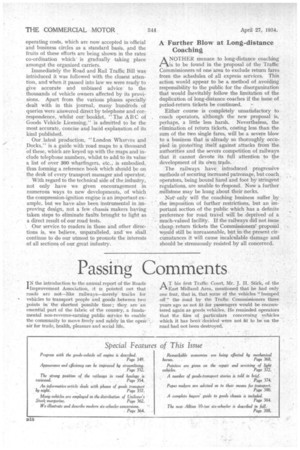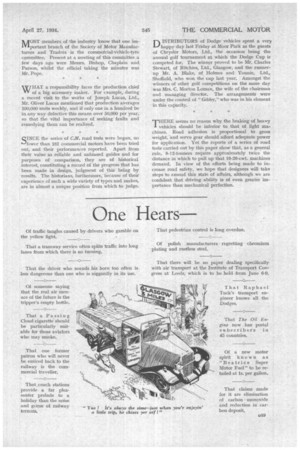Passing Comments
Page 84

Page 85

If you've noticed an error in this article please click here to report it so we can fix it.
IN the introduction to the annual report of the Roads Improvement Association, it is pointed out that roads are not—like railways—merely tracks for vehicles to transport people and goods between two
points the shortest possible time ; they are an essential part of the fabric of the ceuntry, a fundamental non-revenue-earning public service to enable the community to move freely and safely in the open: air for trade, health, pleasure and social life.
AT his first Traffic Court, Mr. J. Stirk, of the
East Midland Area, mentioned that he had only one fear, that is, that some of the vehicles "bumped off" the road by the Traffic Commissioners three years ago as not fit for passengers would be encountered again as goods vehicles. He reminded operators that the files of partieulars concerning vehicles which it has been decided were not fit to be on the road had not been destroyed.
MMOST members of the industry know that one imvIportant branch of the Society of Motor Manufacturers and Traders is the commercial-vehicle-tyre committee. Present at a meeting of this committee a few days ago were Messrs. Bishop, Chaplain and Parson, whilst the official taking the minutes was Mr. Pope.
WHAT a responsibility faces the production chief of a big accessory maker. For example, during a recent visit to the works of Joseph Lucas, Ltd., Mr. Oliver Lucas mentioned that production averages 100,000 units weekly, and if only one in a hundred be in any way defective this means over 50,000 per year, so that the vital importance of seeking faults and remedying them can be realized.
"' INCE the series of G.M. road tests were begun, no
fewer than 181 commercial motors have been tried out, and their performances reported. Apart from their value as reliable and unbiased guides and for purposes of comparison, they are of historical interest, constituting a record of the progress that has been made in design, judgment of this being by results. The historians, furthermore, because of their experience of such a wide variety of types and makes, are in almost a unique position from which to judge.
DISTRIBUTORS of Dodge vehicles spent a very L./ happy day last Friday at Moor Park as the guests of Chrysler Motors, Ltd., the occasion being the annual golf tournament at which the Dodge Cup is competed for. The winner proved to be Mr. Charles Stewart, of Ritchies, Ltd., Glasgow, and the runnerup Mr. A. Blake, of Holmes and Younie, Ltd., Sheffield, who won the cup last year. Amongst the winners of other golf competitions on the same day was Mrs. C. Morton Lomax, the wife of the chairman and managing director. The arrangements were under the control of " Gibby," who was in his element in this capacity.
THERE seems no reason why the braking of heavy vehicles should be inferior to that of light machines. Road adhesion is proportional to gross weight, and servo gear should afford adequate power for application. Yet the reports of a series of road tests carried out by this paper show that, as a general rule, 8-12-tonners require approximately twice the distance in which to pull up that 10-20-cwt. machines demand. In view of the efforts being made to increase road safety, we hope that designers will take steps to amend this state of affairs, although we are confident that driving ability is of even greater importance than mechanical perfection.




















































































































































































